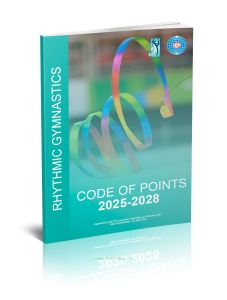Издание на английском языке
The FIG Rhythmic Gymnastics Technical Committee (FIG RG TC) is pleased to present the Rhythmic Gymnastics Code of Points for implementation from January 1st, 2025, to December 31st, 2028.
The primary purposes of the Code of Points include guiding coaches and athletes in their development of rhythmic gymnastics exercises and providing a standardised, objective means of evaluating rhythmic gymnastics performances.
The Rhythmic Gymnastics Code of Points for 2022-2024 saw large modifications to most score components. At the timepoint of finalizing of the Code of Points for 2025-2028, the broad understanding of and the full impact of the 2022-2024 modifications are only starting to stabilize. Therefore, the FIG RG TC has concluded that a new round of reinventing the score components would be premature. Instead, the intentions of the present revision have been to :
- correct some problems identified during the 2022-2024 cycle,
- incorporate clarifications that have been provided during the 2022-2024 cycle,
- simplify some aspects of the evaluation, and
- improve the possibilities of a healthy sporting career for the athletes.
During the revision, valuable input has been received, considered, and respected from a number of entities:
- FIG Anti-Doping, Medical and Mental Health Commission;
- Meetings with top 10 coaches;
- Feedback from the FIG Member Federations;
- Round table meetings with the FIG Member Federations during World Championships;
- Continental Unions and their Rhythmic Gymnastics Technical Committee Presidents;
- Meetings between the Athlete Representative and the athletes;
- Through the regular dialogues with the athletes and judges during the cycle.
Contents
Part 1 – Individual exercises
A. Generalities individual exercises
1. Competitions and programs
2. Timing
3. Panel composition: official championships and other competitions
4. Judges’ meetings/instructions
5. Final score calculation
6. Score inquiries
7. Floor area
8. Interrupted exercise
9. Apparatus
10. Competition attire of the gymnasts
11. Requirement for musical accompaniment
12. Discipline of the gymnasts
13. Discipline of the coaches
14. Penalties taken by the time, line, and responsible judge
B. Difficulty (D) individual exercises
1. Difficulty overview
2. Difficulty of body (DB)
3. Apparatus technical groups
4. Dynamic elements with rotation (R)
5. Difficulty of apparatus (DA)
6. New original apparatus difficulty
7. Difficulty score (D)
8. Jumps/leaps
9. Table of jump/leap difficulties
10. Balances
11. Table of balance difficulties
12. Rotations
13. Table of rotation difficulties
C. Artistry (A) individual exercises
1. Evaluation by the artistry jury
2. Artistic structure and performance: composition objectives
3. Guiding idea and character
4. Expression
5. Dance steps combinations
6. Dynamic changes: creating contrasts – and effects with music
7. Connections
8. Rhythm and ending with music
9. Use of the space
10. Interruption of continuity
11. Individual artistry faults
D. Execution (E) individual exercises
1. Evaluation by the execution jury
2. Explanations for execution penalties
3. Body movements
4. Technique with each type of apparatus
5. Technique of all apparatus
E. Annex individual exercises
1. Apparatus program
2. Technical program for junior – individual exercises
3. Difficulty overview for junior individual exercises
4. Difficulty of body (DB)
5. Apparatus technical elements
6. Dynamic elements with rotation (R)
7. Difficulty of apparatus (DA)
8. Difficulty score (D)
9. Artistry and execution
Part 2 – Group exercises
A. Generalities group exercises
1. Competitions and programs
2. Number of gymnasts
3. Timing
4. Panel composition: official championships and other competitions
5. Judges’ meetings/instructions
6. Final score calculation
7. Score inquiries
8. Entry
9. Floor area
10. Interrupted exercise
11. Apparatus
12. Competition attire of the gymnasts
13. Requirement for musical accompaniment
14. Discipline of the gymnasts
15. Discipline of the coaches
16. Penalties taken by the time, line, and responsible judge
B. Difficulty (D) group exercises
1. Difficulty overview
2. Difficulty of body (DB)
3. Apparatus technical elements
4. Difficulty with exchange (DE)
5. Dynamic elements with rotation (R)
6. Difficulty with collaboration (DC)
7. Difficulty score (D)
C. Artistry (A) group exercises
1. Evaluation by the artistry jury
2. Artistic structure and performance: composition objectives
3. Guiding idea and character
4. Expression
5. Dance steps combinations (S)
6. Dynamic changes: creating contrasts – and effects with music
7. Collective work
8. Connections
9. Rhythm and ending with music
10. Formations
11. Interruption of continuity
12. Body construction/raised positions
13. Contact between the apparatus and gymnasts
14. Group artistry faults
D. Execution (E) group exercises
1. Evaluation by the execution jury
2. Explanations for execution penalties
3. Group work
4. Body movements
5. Technique with each type of apparatus
6. Technique of all apparatus
E. Annex group exercises
1. Apparatus program
2. Technical program for junior – group exercises
3. Difficulty overview for junior group exercises
4. Difficulty of body (DB)
5. Apparatus technical elements
6. Difficulty with exchange (DE)
7. Dynamic elements with rotation (R)
8. Difficulty of apparatus (DA)
9. Difficulty score (D)
10. Artistry and execution
Артикул 00-01041529




